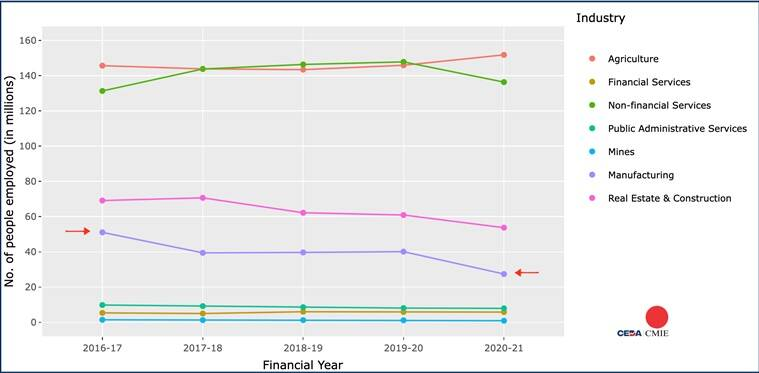Why has Indian manufacturing been losing jobs since 2016?
Why in the News?
- Recently, the State of Working India (SWI) 2021 was brought out by the researchers at Azim Premji University. The report, which is an annual feature, documented the impact of one year of Covid-19 in India, on jobs, incomes, inequality, and poverty.
- Most shocking fact from the report is that the number of people employed in the manufacturing sector of the economy has come down from 51 million to 27 million i.e. almost halving in the space of just four years.
Employment Trends in the Industry Sector
- The following Chart shows employment data across seven sectors, viz. agriculture, mines, manufacturing, real estate and construction, financial services, non-financial services, and public administrative services. Between them, these sectors account for 99% of total employment in India.

- The number of people employed in agriculture has been going up since the pandemic due to reverse migration.
- Jobs in textiles manufacturing have come down from 12.6 million in 2016-17 to just 5.5 million in 2020-21. Over the same period, employment in construction material firms has shrunk from 11.4 million to just 4.8 million.
Why is Indian manufacturing failing to create jobs?
- Economists point out that Indians have always consumed relatively less of manufacturing goods and relatively more of food and services.
- Indian policymakers repeatedly focus more about the capital intensive industries than labour-intensive industries. The labour-intensive ones (such as leather, handicrafts, textiles etc.) were reserved for the small-scale industry framework.
- The labour-intensive manufacturing firms could not match the capital-intensive firms in terms of GDP value or growth of output, they did have a distinct advantage of creating more jobs.
- Experts argue that India did not push for integrating its labour-intensive manufacturing in the global supply chains by aggressively following exports.
What has happened since 2016-17?
- Data shows things have become worse over the past five odd years despite the Indian government unveiling its ambitious Make in India (MII) initiative and the latest Production-Linked Incentive (PLI) scheme.
- 70% of India’s manufacturing jobs are in the informal sector. Both the demonetisation announced in 2016 as well as the introduction of GST in 2017 dented the manufacturing firms in the informal sector and steadfastly redistributed the demand in favour of organised manufacturing.
- In other words, the growing rift in the fortunes of informal and formal manufacturing could be the reason why India is seeing such a massive decline in manufacturing jobs.
Way Forward
- India’s best hope for creating new jobs and soaking up excess unskilled labour from agriculture, requires policymakers to target labour-intensive firms, especially in the informal sector and help them- through better infrastructure and easier regulatory support- to create millions of new jobs.
- There is also an urgent need to make more credit supply and incentives to MSMEs (Micro, Small and Medium Enterprises).
Reference:
Subscribe
Login
0 Comments
